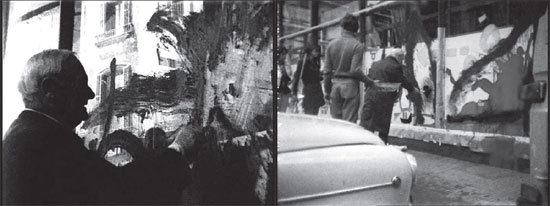Pere Portabella
Miró, l’altre / Miró, the other, 1969
16mm / DVD, 15’
Script: Pere Portabella,
Photography: Manuel Esteban,
Music: Carles Santos,
Editing: Teresa Alcocer,
Production: José Pedro Villanueva / Colegio Oficial de Arquitectos de Barcelona (COAC) / Films 59

One of the most significant projects at COAC was the film Miró, the other (1969) by Pere Portabella, who recorded the action paintings of Joan Miró at the front glass of the building – and the removal of the same, carried out by the artist himself.
„This short film not only records this polemic, artistic performance by Miró, it also sets forth a conceptual axis, a combative, ideological intervention at the intersection of two views, which Pere Portabella also articulates in another of his clandestine films against the Franco regime (the editing por retroceso and the repetition of shots does not allow it to be understood as a realistic record of an event or as a simple document). By confiding in the setting and the expressive materials of the cinema, Pere Portabella eliminates any kind of verbal discourse in order to stick to the images and the music as the only way to elaborate his small political manifesto. In this manner, the black & white/color dichotomy functions like a surrealistic mechanism in the fight against the dictatorship (this dichotomy is found in several short films and in a feature length by Pere Portabella during this period but disappears from his films after the death of Franco). The initial images in this film, shot in the interior of the building are in black and white, while there is color during the creation of this urban work, on the windows of the Architects Association in primary colors, when Miró superimposes messy strokes and spatters of a deep black. On the street, in front of a crowd of curious onlookers, Miró darkens the chromatic joy of the building’s images, forming a graffiti of denouncement, a black protest gesture that is almost expressionist, while at the same time he creates a break with the projected well-being and the public norms of urban behavior during the dictatorship. This breaking-away gesture self-annihilates (again now in black & white) as Miró himself erases his strokes, in order to reveal how the survival of such impertinence is impossible in this context. The short film ends in black & white images of Miró inside the building, again enclosed in a grey space, ostracized in his own country, a metaphor of the impossibility of prolonging the subversion of the social order ruled by totalitarianism. By propagating the ritual until the present, Pere Portabella transcended that limit: a film that combats a time of censorship.“
(Diego Trerotola, in: http://www.pereportabella.com/eng/laltre_esp.html)
